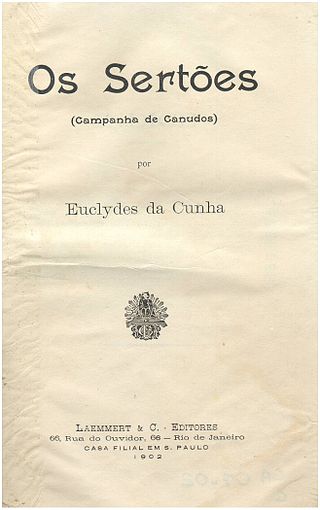
Sebastianism is a Portuguese messianic myth, based on the belief that King Sebastian of Portugal, who disappeared in the battle of Alcácer Quibir, would reappear and return to Portugal at some critical point in the future. The belief gained momentum after an interpretation by priest António Vieira of the second chapter of the Book of Daniel and the Book of Revelation. In Brazil the most important manifestation of Sebastianism took place in the context of the Proclamation of the Republic, when movements defending a return to the monarchy emerged. It is categorised as an example of the King asleep in mountain folk motif, typified by people awaiting a hero. The Portuguese author Fernando Pessoa wrote about such a hero in his epic Mensagem.

Euclides da Cunha was a Brazilian journalist, sociologist and engineer. His most important work is Os Sertões, a non-fictional account of the military expeditions promoted by the Brazilian government against the rebellious village of Canudos, known as the War of Canudos.

Antônio Conselheiro, in English "Anthony the Counselor", real name Antônio Vicente Mendes Maciel, was a Brazilian religious leader, preacher and founder of the village of Canudos, the scene of the War of Canudos (1896–1897), a civil rebellion against the central government which was brutally stamped out with the loss of more than 25,000 lives.

The War of Canudos was a conflict between the First Brazilian Republic and the residents of Canudos in the northeastern state of Bahia. It was waged in the aftermath of the abolition of slavery in Brazil (1888) and the overthrow of the monarchy (1889). The conflict arose from a millenarian cult led by Antônio Conselheiro, who began attracting attention around 1874 by preaching spiritual salvation to the poor population of the sertão, a region which suffered from severe droughts. Conselheiro and his followers came into attrition with the local authorities after founding the village of Canudos. The situation soon escalated, with Bahia's government requesting assistance from the federal government, who sent military expeditions against the settlement.
A jagunço, from the Portuguese zarguncho, is an armed band or bodyguard, usually hired by plantation owners and "colonels" in the backlands of Brazil, especially in Northern Brazil. They were hired to protect their employer, big land owner, against invaders and feudal enemies, and also to control their slaves and indentured servants. Some farmers formed their own private militias with a number of heavily armed jagunços. There were also free-lancing or mercenary jagunços, who could be hired for temporary conflicts, as vigilantes, or for contract murders. Local folklore says that jagunços with yellow eyes were particularly fearsome and efficient.

Paulo Afonso is a city in Bahia, Brazil. It was founded in 1958.

Os Sertões, translated as Rebellion in the Backlands, is a book written by the Brazilian author Euclides da Cunha. Mixing science and literature, the author narrates the true story of a war that happened at the end of the 19th century in Canudos, a settlement of Bahia's Sertão ("backland"), an extremely arid region where, even now, struggles against poverty, drought and political corruption continue. During the war (1893–1897) against the republican army, the sertanejos were commanded by a messianic leader called Antônio Conselheiro.

The Vaza-Barris River is a river in northeastern Brazil. The Vaza-Barris originates in northeastern Bahia state, and flows east through Bahia and Sergipe states to empty into the Atlantic Ocean near São Cristóvão.
Raso da Catarina Ecological Station is a strictly protected ecological station in the state of Bahia in Brazil. It lies in the Raso da Catarina ecoregion of the Caatinga biome.

Inhambupe is a municipality in the state of Bahia in the North-East region of Brazil. The town lies along Highway 110, approximately 161 kilometres (100 mi) by road north of Salvador. In 2022 it had an estimated 33,790 inhabitants.

Uauá [pronounce: uaua] is a municipality in the state of Bahia in the North-East region of Brazil.

Jeremoabo is a municipality in the state of Bahia in the North-East region of Brazil.
Macururé is a municipality in the state of Bahia in the North-East region of Brazil.

Events in the year 1896 in Brazil.

Events in the year 1897 in Brazil.

The Serra Branca / Raso da Catarina Environmental Protection Area is an environmental protection area in the state of Bahia, Brazil. Its sandstone cliffs are home to the endangered Lear's macaw.

The Raso da Catarina is an ecoregion in the caatinga biome of Bahia and Pernambuco, Brazil. It is a sandstone plateau, much eroded, that is extremely dry for most of the year. Vegetation includes low bushes, often thorny, cacti and bromeliads.

The Cocorobó Dam is a dam in the state of Bahia, Brazil. It provides a reservoir of water for irrigation and drinking in the arid caatinga environment of the Raso da Catarina. The reservoir covers the ruins of the city of Canudos, scene of the War of Canudos in 1896–97.

The Canudos State Park is a state park in Bahia, Brazil. It protects the area of the War of Canudos, where peasants of mixed blood were massacred by Republican soldiers in 1896–97.

Vale of Tears: Revisiting the Canudos Massacre in Northeastern Brazil, 1893–1897 is a book by historian Robert M. Levine published by the University of California Press in 1992. The book goes into detail of the Massacre that occurred in the Northeastern state of Bahia. Focused on the events from 1893-1897, the book looks at the life of Antônio Conselheiro and the city that he created. Antônio Conselheiro was a Brazilian religious leader, preacher, and the creator of Canudos, the scene of the War of Canudos (1896-1897). This war was between the state of Brazil and the 30,000 settlers that followed Antônio Conselheiro. After multiple confrontations the central government brutally took control of the city killing more than 15,000 people and destroying what was left of the town.


















